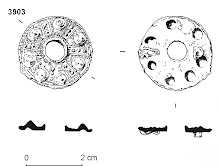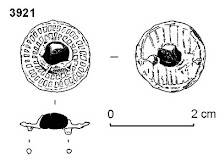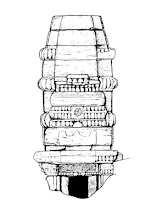Although we finished digging in December 2013 work is far
from finished on our project at Horse and Groom Inn in the Cotswolds. Over the
past few months a team of specialists have been looking in detail at all the
artefacts, animal and human bone and environmental samples from the site, and
writing detailed assessment reports on them. Over at Urban Archaeology we have
also been busy checking and collating records, digitising site plans, briefing
the specialists and creating a database and GIS of all the site data. We have
also been writing a detailed account of what we found at the site, a framework
into which the specialist data will be slotted later. This document, known as a
post-excavation assessment (PXA) is an important milestone in the site's
progress, a point where we stop and assess what we found on site, look at its
potential and its significance, and decide what further work is required to
analyse and publish the site findings.
The PXA is not a complete and final report: once it is
approved by the local planning archaeologist work will start on the analysis
phase and the preparation of the final publication text, which will be
published in an academic journal. Meantime we have now received all the
specialist reports and we thought we would give an update on some of our
findings.
One of the finds on site that captured the most attention
was the discovery of an adult human skeleton that probably dates from the
Middle Iron Age. What we didn't say at the time was that there was a further
burial alongside the adult skeleton, and that we had recovered other probable human
remains from the site.
We have now received the detailed osteological report on the
human remains, and it turns out that there were the remains of five individuals
buried on the site: the adult crouched burial, a baby buried within the
backfill of his burial, and three other fragmentary baby skeletons or parts of
skeletons.
We identified the crouched burial as probably dating from
the Middle Iron Age as the grave backfill contained large, conjoining, sherds
of a Middle Iron Age jar that may have been deliberately thrown into the grave.
It is possible that this pottery is residual and the burial is later than the
Middle Iron Age -there are instances of similar Roman crouched burials from the
area- however there was no Roman pottery
in the grave and no other Middle Iron Age features nearby that could have provided
such large pieces of Middle Iron Age pottery. We will be using Carbon Dating to
establish the date of the burial.
The first skeleton is also the most complete as he had been
buried in a crouched position within a small pit cut down into the natural
limestone bedrock. On site we identified the skeleton as being of an adult male
(and luckily osteologist Gaynor Western agrees!) The skeleton is a of a male who
probably died aged between 25 and 40 and who stood 1.76m tall (5 foot 9) (slightly
taller than the known average for Iron Age males). Detailed inspection of the
skeleton showed that he had slight congenital or developmental abnormalities on
his spine and ribs, but nothing that would have affected him adversely during
his life. There were no signs of any diseases, injuries or other trauma on his bones,
and his teeth were in good condition.
The other skeletons were all fragmentary, and all were from
new born or very young babies. Their bones were very fragile and we can tell
less about these individuals. The dating of the other three babies is
uncertain, they were all recovered from contexts dated to the medieval period,
but all may be significantly older. It is not inconceivable that the burials
may date from the Iron Age or Roman period given their proximity to the
concentration of Iron Age and Roman activity on the site.














No comments:
Post a Comment